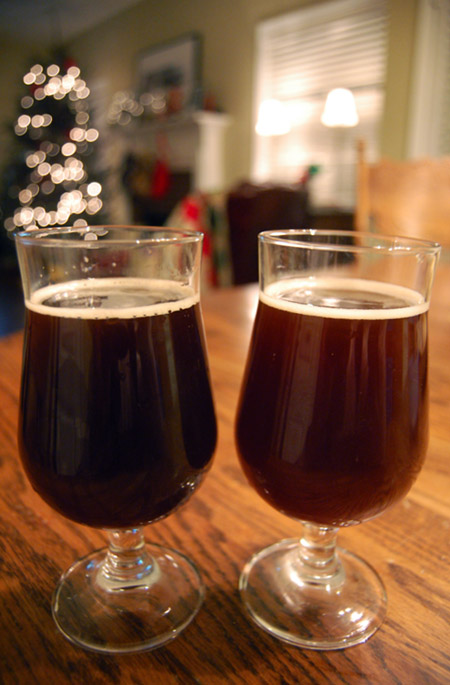Warp Speed, Mr. Scott!
- Posted by Josh on December 13, 2010 at 10:11pm
- Categories: Beer vs. Beer, Commercial Brews, Homebrews, Pictures
- No Comments »
Tonight’s main event pits our own latest brew, Hump’s Fat Bastard, against a potential competitor: Rogue’s McRogue Scotch Ale.
In this corner, the champion, standing at 8% alcohol by volume, made with seven types of malts and a single hop variety, is the Fat Bastard (with a hefty 1.034 finishing gravity — told you it was fat). And in the other corner, the challenger from the west coast, made with five types of malts and three varieties of hops, standing at 7% alcohol by volume, is McRogue.
Fat Bastard was crafted using British pale (Maris Otter), dark Munich, British crystal (55°L and 150°L), special roast, and peated malts as well as unmalted roasted barley. It was bittered with U.K. Phoenix hops and lightly spiced with crushed coriander seed (intended to be a subtle nod to Traquair Jacobite – a Scotch ale made with generous amounts of coriander).
McRogue was built using amber, pale, and chocolate malts; rolled oats; and Rogue’s own home-grown Dare malts. McRogue features Kent Goldings and Willamette hops as well as Rogue’s own home-grown Revolution hops.
Fat Bastard on the left; McRogue on the right

Appearance: Both beers pour brown, with less than stellar clarity, and medium-sized light tan heads. The Rogue brew is cloudier and not quite as dark. The fat bastard is nearly black except when held to the light, revealing a hazy (but not as opaque as the Rogue) dark brown.
Aroma: The Rogue has a distinct chocolate character to the aroma whereas Fat Bastard has a distinctly fruity character (no fruit in particular – just the vaguely fruity aroma of esters, produced by ale yeast during fermentation). The variance is significant and the contrast is great enough that each beer accentuates the character of the other. In other words, the McRogue brew seems even more chocolatey after sampling the Fat Bastard, and – similarly – the Fat Bastard seems to be more distinctly fruity after a sip of the McRogue. The Fat Bastard also has a touch of drying ethanol in the aroma, divulging the brew’s greater strength. Despite the use of a small portion of peated malt and coriander in Fat Bastard, it is lacking any noticeable contributions from either.
Flavor: The flavors follow the aromas in both beers. The McRogue is thick and malty with a surprisingly strong chocolate character with other hints of sweet and roasty malts. The Fat Bastard, on the other hand, has a more straight-forward malt character that has a slightly rougher edge from alcohol, a subtle chocolate character, and continuing tones of fruity esters. Both finish dry with a hint of ethanol. Fat Bastard is a touch more warming in the finish.
Overall: Though I formulated the recipe for Hump’s Fat Bastard with the intent that it would reach down to a 1.028 finishing gravity (which would translate to just over 9% alcohol), I’m still quite happy with the finished product. I actually prefer it to the Rogue brew. However, my better half (wife), prefers the Rogue. Of course, she’s also quite partial to chocolate.
So, the final verdict? A draw. Perhaps next time we need an odd number of votes cast.
We’ll have to schedule a re-match, pitting an aged bottle of McRogue against some aged Fat Bastard to see how they smooth out.